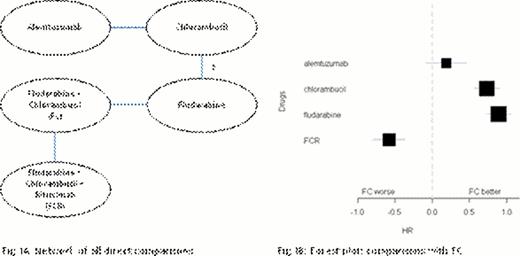Abstract
Abstract 4596
Several therapies, composed by single agent or combinations, are available for untreated patients in chronic lymphocytic leukemia and it is difficult to rank treatments according to their effect size when not all treatments have been compared directly. Direct randomized comparison is the most reliable way of comparing treatments but when the number of available treatments increases the number of possible pairwise comparisons increases quadratically, so it is common for only a small fraction of the possible comparisons to be performed. Network meta-analysis permits to add indirect estimates for assessing the relative effectiveness of two treatments when they have not been compared directly in a randomized trial but have each been compared to other treatments. Network meta-analysis of randomized controlled trials was used to combine direct and indirect estimates of the effect of four drugs and their combinations from five randomized controlled trials (Fig. IA) in CLL patients based on a systematic review conducted by M.M. Cheng et al. (Cancer Treatment Review 2012) on 2625 patients where Chorambucil, Fludarabine, Rituximab, Alemtuzumab, Bendamustine, Cladribine and Pentostatin have been considered as primary first-line agents for CLL. Patients were younger (59–65 years), had good performance status (ECOG: 0–1) and early stage disease (Rai 0-II, Binet A or B). We carried out an analysis based on the endpoint of PFS, described as the duration of the time from randomization until disease progression or death from any cause and to consider the heterogeneity among the studies a random effects model was performed. The differences in PFS of all therapies considered in the analysis were compared with combination of Fludarabine and Chorambucil (FC). The results were summarized by forest plot (Fig IB) in terms of reduction or increase of Hazard Ratio. As the forest plot shows, FCR has relatively higher potential of preventing disease progression in younger patients affected by chronic lymphocytic leukemia.
Respect to a traditional meta-analysis, which usually compares only two treatments, network meta-analysis is a useful method to combine direct and indirect comparisons of treatments from RCTs and to analyze the hierarchy in treatment effects and tests for consistency of the relations of the network.
No relevant conflicts of interest to declare.
Author notes
Asterisk with author names denotes non-ASH members.


This feature is available to Subscribers Only
Sign In or Create an Account Close Modal